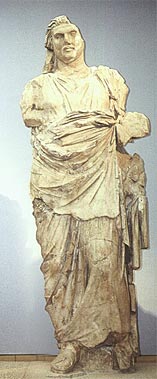|
Halicarnassus lived its brightest years during the reign of Mausolus (377-353 BC). During
his reign Mausolus transferred his capital from Mylasa (today Milas) to Halicarnassus.
|

|

|
|

Statue of King Mausolos
exhibited in the British Museum

|
|
In the fourth century B.C. great changes took place in  Caria. After it came
again under Persian dominion, it was ruled by the satrap Hecatomnos of Caria. After it came
again under Persian dominion, it was ruled by the satrap Hecatomnos of  Mylasa, from his
death on in 377 by his son Mausolus. The kingdom of Caria in the western part of Asia Minor (Turkey) was so far
from the Persian capital that it was practically autonomous. Mylasa, from his
death on in 377 by his son Mausolus. The kingdom of Caria in the western part of Asia Minor (Turkey) was so far
from the Persian capital that it was practically autonomous.
Hecatomnus had been ambitious and had taken control of several of the neighboring cities
and districts. Mausolus extended the territory even further so that it finally included most of southwestern Asia
Minor.
Halicarnassus lived its brightest years during the reign of Mausolus (377-353 BC). During his reign Mausolus transferred
his capital from Mylasa to Halicarnassus. Until then Halicarnassus was a comparatively small city, but Mausolus,
observing her natural advantages for fortification and commerce from sea. His ideas were never on a niggardly scale,
and he set out to create a worthy capital city.
He transplanted the inhabitants of six of the eight Lelegian cities from the surrounding
area, the peninsula. These were of varying size, but some at least, if we may judge by the tribute they paid to
Athens in the fifth century, seem to have been comparable to Halicarnassus herself, and the population of the new
city must have been four or five times that of the old.
Mausolus was well established in his new capital by 367 BC, and before the end of his reign he ruled from here
over a kingdom that included all of Caria and considerable portions of Ionia and Lycia, as well as the islands
of Rhodes, Cos, and Chios. Mausolus enclosed his capital at Halicarnassus with a great circuit of powerful defense
walls studded with watch-towers at regular intervals, along with three separately walled citadels, some three and
a half miles long, of which parts are standing today (recently brought into shape by Ericsson-Türkcell, see
 Myndos Gate).
Myndos Gate).
Mausolos taxed his inhabitants heavily to pay for these and other grand scale projects, and it is said that he
even imposed a levy on hair longer then shoulder length.
Mausolus, with his queen  Artemisia, ruled over Halicarnassus and the surrounding
territory for 24 years. For his own residence Mausolus built a palace with walls of dried brick, finished in all
parts with marble from the Sea of Marmara. Nothing of this palace survives today, and its position has been the
subject of much discussion. Artemisia, ruled over Halicarnassus and the surrounding
territory for 24 years. For his own residence Mausolus built a palace with walls of dried brick, finished in all
parts with marble from the Sea of Marmara. Nothing of this palace survives today, and its position has been the
subject of much discussion.
Then in 353 BC. Mausolus died, leaving his queen Artemisia, who was also his sister (It was the custom in Caria
for rulers to marry their own sisters), broken-hearted. It is not certain that Mausolos initiated the construction
of the monument of moussoleion later, but as a tribute to him, Artemisia decided to build him the most splendid
tomb in the known world. It became a structure so famous that it was called one of the Seven Wonders of the world.
Mausolus's name is now associated with all stately tombs through our modern word  Mausoleum. Mausoleum.

|

|
|
Halicarnassus,
city on the Ceramic Gulf of ancient Caria, now the Gulf of Gokova in southwest Turkey. The city was founded by
the Dorians and was conquered by the Persians in the 5th century BC. Later, having freed itself from Persian rule,
the city became the capital of the independent province of Caria and the seat of the Carian kings, the most famous
of whom was Mausolus (flourished about 376-353 BC). He was commemorated with a tomb called the Mausoleum, one of
the Seven Wonders of the Ancient World. The Greek historians Herodotus and Dionysius of Halicarnassus were born
in the city. In the beginning of the 15th century, Halicarnassus was fortified by the Knights of Saint John of
Jerusalem, who named it Petronion in honor of St. Peter. Ruins of their castle and of the ancient city are found
at Bodrum.
|


|